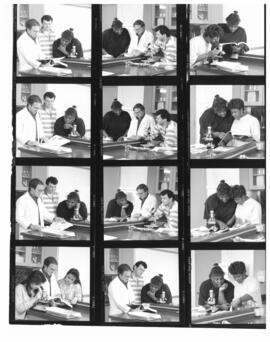The Charlotte Friend collection provides an excellent view of the scientist as well as the non-research side of a researcher's career. These files document Dr. Friend's role as a professional involved with numerous organizations as a leader, committee member, and reviewer; as an administrator of her own lab, with the concomitant need to write and receive grants from outside funding; and, at a lessening degree as time went on, as a teacher. Dr. Friend's research efforts are harder to trace here. The natural source for this would be the research notebooks, but these are now lost, with only a few remaining in the Center for Experimental Cell Biology. In this collection, the Manuscripts Series has the finished product of this research, although this series ends in 1979. There is also the Meetings, Speeches and Notebooks Series, which shows somewhat the progress of her work. Scattered throughout the Correspondence and Alphabetical series are also fleeting references to her work. There is also a small set of glass lantern slides from 1956-1963 (Box 44) that show experimental mouse specimens and cells. These were contained in a slide box with the initials C.P.R. on the top. It seems likely that the box once belonged to Cornelius P. Rhoads, who served as Director of Memorial Hospital from 1940-1953 and was the founding Director of Sloan Kettering Institute, where he served until his death in 1959. Another facet of the collection is the insight it provides into the world of cancer research during an important era, an era which Dr. Friend herself helped propel. This was the time, starting in the 1950s, when scientists gradually turned to an acceptance of viruses as cancer causing agents in humans. The evolution of the field may be traced through the conference programs (Box 33-38), the journal articles that Dr. Friend reviewed (Box 2, Box 7-19), as well as through the correspondence and her own research. These papers also show the intimacy of the cancer research community itself, at least at the level at which Dr. Friend operated. These papers provide information on women's role in science. Dr. Friend in some ways held an unusual position. Her discovery of the Friend leukemia virus established her reputation very early in her career. Perhaps because of this, she felt that she herself was not held back by being a woman, with the exception of some wage discrimination. Still, she believed that science truly had been a man's world and that it would take conscious and steady efforts by women to change this. For her part, this involved nominating women to positions of authority in organizations; suggesting women speakers for programs; speaking out about women's issues; serving as a role model to young women from grade school to graduate school; and ultimately, by taking time from her own lab to serve in prominent positions in professional associations. The latter is reflected in the Alphabetical Series in files on the Harvey Society, the American Association for Cancer Research, the New York Academy of Sciences, and the National Academy of Sciences. Finally, the Charlotte Friend Papers give a great deal of insight into her as a person. She cared deeply about and was very involved with her family (Personal Series). She loved to travel, but always loved New York. She wrote letters to congressmen and mayors on issues she cared about, including support for Israel, cuts in research funding, the status of women, and abortion rights (Box 42, f.7). Her support staff loved her, and many times she functioned as a mother hen to the group. Still, she seemed to be the mentor to few graduate students, and colleagues did not remain many years in her lab. She was a complex woman whose intricacies are clearly displayed in this collection.
Friend, Charlotte, 1921-1987Elements area
Taxonomy
Code
Scope note(s)
- All of the divisions of the natural sciences dealing with the various aspects of the phenomena of life and vital processes. The concept includes anatomy and physiology, biochemistry and biophysics, and the biology of animals, plants, and microorganisms. It should be differentiated from BIOLOGY, one of its subdivisions, concerned specifically with the origin and life processes of living organisms.
Source note(s)
- Medical Subject Headings
Display note(s)
Hierarchical terms
Biological Science Disciplines
Biological Science Disciplines
- NT Anatomy
- NT Biochemistry
- NT Biology
- NT Neurosciences
Equivalent terms
Biological Science Disciplines
- UF Biologic Sciences
- UF Biological Science
- UF Biological Sciences
- UF Life Sciences
- UF Science, Biological
- UF Sciences, Biological







